Mechanics: State, evaluate and apply mechanical advantage
Unit 1: Wheels and axles and their mechanical advantage
Leigh Kleynhans
Unit outcomes
By the end of this unit you will be able to:
- Define torque.
- Identify the application of torque in simple machines.
- Describe and identify the mechanical advantage in a wheel and axle.
What you should know
Before you start this unit, make sure you can:
- Identify, describe, and apply principles of simple machines and mechanical advantage. See level 2 subject outcome 2.4 to revise this.
Introduction
You have learnt that simple machines are devices that can be used to multiply an applied force – often at the expense of the distance through which the force is applied. Levers, gears, pulleys, wedges, and screws are some examples of machines. Energy is still conserved for these devices because a machine cannot do more work than the energy put into it. However, machines can reduce the input force that is needed to perform the job. You have also learnt that the ratio of output to input force for any simple machine is called its mechanical advantage (MA).
What is torque?
The ability of a force to rotate a lever around a fixed point is measured by a quantity called .
Torque depends on the size of the force and the . The perpendicular distance from the axis of rotation to a line drawn along the direction of the force is called the lever arm (the distance, d, from the fixed to the point at which the force is applied).
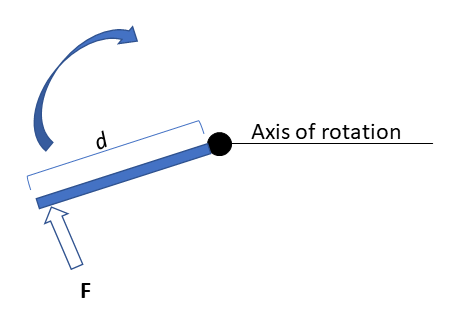
Application of torque in simple machines
To illustrate how torque is used in simple machines, look at figure 2 of a pet flap door.
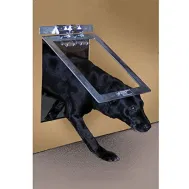
The force F is applied by the dog perpendicular to the pet-flap door. The lever arm is the distance, d, from the dog’s nose to the hinge. If the dog pressed on the door at a higher point, the lever arm would be shorter. As a result, the dog would need to exert a greater force to apply the same torque.
How easily an object rotates depends not only on how much force is applied but also on where the force is applied.
The further the force is from the axis of rotation, the easier it is to rotate the object and the more torque is produced.
Torque is directly proportional to the force applied (effort) and the length of the lever arm. This can be represented mathematically using the following formula:
[latex]\scriptsize \tau =r\bot F[/latex]
Where:
[latex]\scriptsize \tau[/latex] is the torque
[latex]\scriptsize r\bot[/latex] is the length of the lever arm
[latex]\scriptsize F[/latex] is the force or effort
Activity 1.1: Investigate torque using a hinged door
Suggested Time: 10 minutes
What you need:
- a hinged door
- tape
What to do:
In this activity, you will explore how the amount of force required to open a door changes when the lever arm changes.
- Tape the latch of a hinged door so that the door will open when you push without turning the door handle.
- Using only a force perpendicular to the door, push the door open several times by applying a force at different distances from the hinge.
- Compare the relative effort required to open the door when pushing near the edge to that required when pushing near the hinged side of the door.
What did you find?
You should have found that the longer the lever arm (the distance from the hinge to where you applied the force), the less effort (force) was required to open the door. When the lever arm is short, a greater effort (force) is required to rotate the door.
Note
Watch this video to find out more about torque. (Note that you are not required to do calculations for assessment.)
Exercise 1.1
- .
- What quantity describes the ability of a force to rotate an object?
- On what quantities does it depend?
- How would the force needed to open a door change, if you put the handle in the middle of the door?
- What are two things that a cat pushing on a cat-flap door can change to increase the amount of torque applied to the door?
The full solutions are at the end of the unit.
Wheels and axles
The wheel and axle is a machine consisting of a wheel attached to a smaller axle so that these two parts rotate together because a force is transferred from one to the other.
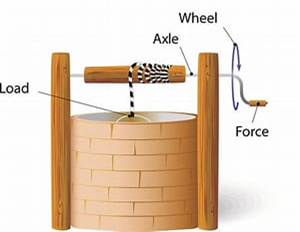
The wheel and axle can be viewed as a version of the lever, with a drive force applied to the perimeter of the wheel and a load force applied to the axle, balanced around the hinge which is the fulcrum.
The simple machine called a wheel and axle refers to any assembly formed by two disks, or cylinders, of different diameters mounted so they rotate together around the same axis. The thin rod which needs to be turned is called the axle and the wider object fixed to the axle, is called the wheel. A tangential force applied to the outer edge of the large disk (greater circumference = longer distance) can exert a larger force on a load attached to the outer edge of the axle (smaller circumference = shorter distance), achieving mechanical advantage. A heavy load can be lifted with a small force.
Circumference is proportional to radius, thus by varying the radii of the axle and/or wheel, mechanical advantage may be gained. The larger the ratio, the greater the multiplication of force (torque) created. If friction is ignored, the ideal mechanical advantage can be expressed using the following formula:
[latex]\scriptsize IMA=\displaystyle \frac{{}}{{}}\displaystyle \frac{{F{{B}_{{out}}}}}{{F{{A}_{{in}}}}}or\displaystyle \frac{{{{R}_{{wheel\text{ }radius}}}}}{{{{r}_{{axle\text{ }radius}}}}}[/latex]
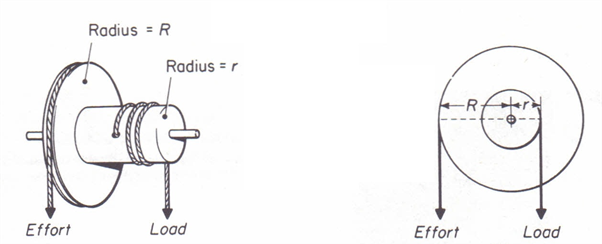
On a powered vehicle, the engine exerts a force on the axle which has a smaller radius than the wheel. The mechanical advantage is therefore much less than 1. The force on the wheels will be less than the force on the axle. However, the friction between wheel and road is quite low, so even a small force exerted on the axle is sufficient to create a force to rotate the wheels of larger radius. The actual advantage of this system lies in the large rotational speed at which the axle is rotating creating a lesser, but effective rotational speed in the wheels.
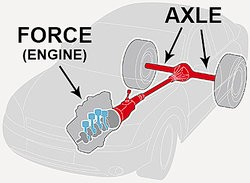
Types of wheel and axle machines
Depending on the point where the force is applied, wheel and axle machines can be classified into two broad categories:
- Machines where force is applied to the wheel
.
In these types of machines, the effort or force is applied to the wheel causing it to rotate. The motion of the simple machine is initiated by the wheel that develops a greater amount of force on the axle. Some examples of such machines include windmills, drills, and screwdrivers. - Machines where force is applied to the axle
.
Here, the effort or the force is applied to the axle (usually at a rapid rate), and this causes the wheel to rotate at a slower rate. This means that the motion initiated by the axle gets transferred to the wheel. Some of the real-life applications that use this type of wheel and axle simple machine include bicycles, Ferris wheels and vehicles.
Note
Watch this video to find out more about a wheel and axle system.
Exercise 1.2
- In the simple machine called a wheel and axle, what is the difference between the component referred to as the wheel and the component referred to as the axle?
- When a force is applied to the wheel, how do the following compare to each other?
- the force on the wheel and the force on the axle
- the energy of the wheel and the energy of the axle
- the rotational distance of the wheel and the rotational distance of the axle
- the rotational speed of the wheel and the rotational speed of the axle
- How would the answers to the above questions change if the force was applied to the axle?
The full solutions are at the end of the unit.
Summary
In this unit you have learnt the following:
- Torque is the measurement of the ability of a force to rotate a lever around a fixed point.
- The torque is determined by the force and the length of the lever arm.
- The shorter the lever arm, the greater the force required for rotation. The longer the lever arm, the less force required for rotation.
- Torque is applied in simple machines such as hinged doors and windows, and when using a wrench to tighten or loosen a bolt.
- A wheel and axle is a simple machine consisting of two disks or cylinders of different radii connected together; the one with the larger radius is called the wheel and the one with the smaller radius is called the axle.
- Less force is required to rotate the larger wheel (over a larger distance), therefore more force is created at the smaller axle (over less distance).
- The mechanical advantage of a wheel and axle where the force is applied to the wheel can be expressed as:
[latex]\scriptsize IMA=\displaystyle \frac{{}}{{}}\displaystyle \frac{{F{{B}_{{out}}}}}{{F{{A}_{{in}}}}}or\displaystyle \frac{{{{R}_{{wheel\text{ }radius}}}}}{{{{r}_{{axle\text{ }radius}}}}}[/latex] - In wheel and axle systems where the force is applied to the axle, there is no mechanical advantage (increase in force) but rotation of the axle rapidly over a short distance can cause the wheel to rotate at a slower speed but over a larger distance.
Unit 1: Assessment
Suggested time to complete: 10 minutes
- Define torque.
- Explain why it is easier to open a window by applying a force near the opening edge rather than near the hinged edge.
- Explain why it is easier to fasten a screw with a screwdriver rather than with your fingers. Support your reasoning by applying the principle of mechanical advantage.
- Which answer correctly describes a wheel and axle movement?
- the wheel and axle move the same distance and turn with the same amount of force
- the wheel moves a lesser distance than the axle but turns with greater force
- the wheel moves a greater distance than the axle but turns with less force
- the wheel moves, while the axle stays completely still
- Explain how a windmill makes use of the principle of the wheel and axle system. Support your answer by applying the principle of mechanical advantage.
The full solutions are at the end of the unit.
Unit 1: Solutions
Exercise 1.1
- .
- torque
- the size of the force and the length of the lever arm (distance from the axis of rotation to where the force is applied)
- It would be more difficult to open the door, more force will be required (the lever arm will be shorter, so to create the same amount of torque the force needs to be greater).
- Increase the force with which they push the door
Apply the force as far as possible from the hinge.
Exercise 1.2
- The wheel has a larger radius/circumference and is bigger than the axle.
- .
- the force on the axle will be greater than that on the wheel
- the energy of the wheel and axle are the same
- the rotational distance covered by the wheel is greater than the rotational distance covered by the axle
- the rotational speed of the axle is greater than the rotational speed of the wheel
- They would not change.
Unit 1: Assessment
- Torque is the measurement of the ability of a force to rotate a lever around a fixed point.
- Torque is proportional to the force applied (effort) and the length of the lever arm (the distance from the hinge to where the force is applied). This is expressed in the formula: [latex]\scriptsize \tau =r\bot F[/latex]. Therefore, to create the amount of torque to open the window, the force will decrease the further it is applied from the hinge of the window.
- This is explained using the mechanical advantage of a wheel and axle system. The handle of the screwdriver has a larger radius than the radius of the screw head. The mechanical advantage of a wheel and axle system is expressed as: [latex]\scriptsize IMA=\displaystyle \frac{{}}{{}}\displaystyle \frac{{F{{B}_{{out}}}}}{{F{{A}_{{in}}}}}or\displaystyle \frac{{{{R}_{{wheel\text{ }radius}}}}}{{{{r}_{{axle\text{ }radius}}}}}[/latex]. Therefore, the output force on the screw head will be greater than the input force on the handle of the screwdriver. It will be easier to turn the screwhead with a screwdriver compared to directly applying a force to the screw head.
- C
- The blades of a windmill have a large radius. When a small force is applied by the wind to the blades, the force on the axle will be greater, as its radius is smaller. This creates a mechanical advantage according to the formula: [latex]\scriptsize IMA=\displaystyle \frac{{}}{{}}\displaystyle \frac{{F{{B}_{{out}}}}}{{F{{A}_{{in}}}}}or\displaystyle \frac{{{{R}_{{wheel\text{ }radius}}}}}{{{{r}_{{axle\text{ }radius}}}}}[/latex]. The increased force on the axle can be used to create kinetic energy to pump water or make electricity.
Media Attributions
- img01_Figure1 © DHET is licensed under a CC BY (Attribution) license
- img02_Figure2 © L Kleynhans is licensed under a CC BY (Attribution) license
- img03_Figure3 © L Kleynhans is licensed under a CC BY (Attribution) license
- img04_Figure4 © L Kleynhans is licensed under a CC BY (Attribution) license
- img05_Figure5 © L Kleynhans is licensed under a CC BY (Attribution) license
the measurement of the ability of a force to rotate a lever around a fixed point
the perpendicular distance from the axis of rotation to a line drawn along the direction of the force
the fixed point around which an object can turn
at a tangent to; a tangent is a line that touches the edge of a circle at one point and is at a right-angle to the radius of the circle
